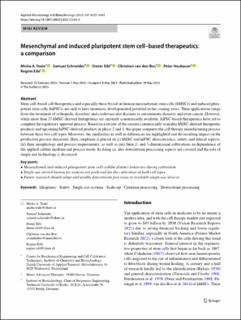Please use this identifier to cite or link to this item:
https://doi.org/10.21256/zhaw-30138Full metadata record
| DC Field | Value | Language |
|---|---|---|
| dc.contributor.author | Teale, Misha A. | - |
| dc.contributor.author | Schneider, Samuel | - |
| dc.contributor.author | Eibl, Dieter | - |
| dc.contributor.author | van den Bos, Christian | - |
| dc.contributor.author | Neubauer, Peter | - |
| dc.contributor.author | Eibl, Regine | - |
| dc.date.accessioned | 2024-03-09T10:12:23Z | - |
| dc.date.available | 2024-03-09T10:12:23Z | - |
| dc.date.issued | 2023-05-08 | - |
| dc.identifier.issn | 0175-7598 | de_CH |
| dc.identifier.issn | 1432-0614 | de_CH |
| dc.identifier.uri | https://digitalcollection.zhaw.ch/handle/11475/30138 | - |
| dc.description | Erworben im Rahmen der Schweizer Nationallizenzen (http://www.nationallizenzen.ch) | de_CH |
| dc.description.abstract | Stem cell-based cell therapeutics and especially those based on human mesenchymal stem cells (hMSCs) and induced pluripotent stem cells (hiPSCs) are said to have enormous developmental potential in the coming years. Their applications range from the treatment of orthopedic disorders and cardiovascular diseases to autoimmune diseases and even cancer. However, while more than 27 hMSC-derived therapeutics are currently commercially available, hiPSC-based therapeutics have yet to complete the regulatory approval process. Based on a review of the current commercially available hMSC-derived therapeutic products and upcoming hiPSC-derived products in phase 2 and 3, this paper compares the cell therapy manufacturing process between these two cell types. Moreover, the similarities as well as differences are highlighted and the resulting impact on the production process discussed. Here, emphasis is placed on (i) hMSC and hiPSC characteristics, safety, and ethical aspects, (ii) their morphology and process requirements, as well as (iii) their 2- and 3-dimensional cultivations in dependence of the applied culture medium and process mode. In doing so, also downstream processing aspects are covered and the role of single-use technology is discussed. KEY POINTS: • Mesenchymal and induced pluripotent stem cells exhibit distinct behaviors during cultivation • Single-use stirred bioreactor systems are preferred for the cultivation of both cell types • Future research should adapt and modify downstream processes to available single-use devices. | de_CH |
| dc.language.iso | en | de_CH |
| dc.publisher | Springer | de_CH |
| dc.relation.ispartof | Applied Microbiology and Biotechnology | de_CH |
| dc.rights | https://creativecommons.org/licenses/by/4.0/ | de_CH |
| dc.subject | Allogeneic | de_CH |
| dc.subject | Downstream processing | de_CH |
| dc.subject | Safety | de_CH |
| dc.subject | Scale-up | de_CH |
| dc.subject | Single-use system | de_CH |
| dc.subject | Upstream processing | de_CH |
| dc.subject.ddc | 610.28: Biomedizin, Biomedizinische Technik | de_CH |
| dc.subject.ddc | 660.6: Biotechnologie | de_CH |
| dc.title | Mesenchymal and induced pluripotent stem cell-based therapeutics : a comparison | de_CH |
| dc.type | Beitrag in wissenschaftlicher Zeitschrift | de_CH |
| dcterms.type | Text | de_CH |
| zhaw.departement | Life Sciences und Facility Management | de_CH |
| zhaw.organisationalunit | Institut für Chemie und Biotechnologie (ICBT) | de_CH |
| dc.identifier.doi | 10.1007/s00253-023-12583-4 | de_CH |
| dc.identifier.doi | 10.21256/zhaw-30138 | - |
| dc.identifier.pmid | 37246986 | de_CH |
| zhaw.funding.eu | No | de_CH |
| zhaw.issue | 14 | de_CH |
| zhaw.originated.zhaw | Yes | de_CH |
| zhaw.pages.end | 4445 | de_CH |
| zhaw.pages.start | 4429 | de_CH |
| zhaw.publication.status | publishedVersion | de_CH |
| zhaw.volume | 107 | de_CH |
| zhaw.publication.review | Peer review (Publikation) | de_CH |
| zhaw.author.additional | No | de_CH |
| zhaw.display.portrait | Yes | de_CH |
| Appears in collections: | Publikationen Life Sciences und Facility Management | |
Files in This Item:
| File | Description | Size | Format | |
|---|---|---|---|---|
| 2023_Teale-etal_Mesenchymal-and-induced-pluripotent-stem-cell–based-therapeutics.pdf | 1.68 MB | Adobe PDF |  View/Open |
Show simple item record
Teale, M. A., Schneider, S., Eibl, D., van den Bos, C., Neubauer, P., & Eibl, R. (2023). Mesenchymal and induced pluripotent stem cell-based therapeutics : a comparison. Applied Microbiology and Biotechnology, 107(14), 4429–4445. https://doi.org/10.1007/s00253-023-12583-4
Teale, M.A. et al. (2023) ‘Mesenchymal and induced pluripotent stem cell-based therapeutics : a comparison’, Applied Microbiology and Biotechnology, 107(14), pp. 4429–4445. Available at: https://doi.org/10.1007/s00253-023-12583-4.
M. A. Teale, S. Schneider, D. Eibl, C. van den Bos, P. Neubauer, and R. Eibl, “Mesenchymal and induced pluripotent stem cell-based therapeutics : a comparison,” Applied Microbiology and Biotechnology, vol. 107, no. 14, pp. 4429–4445, May 2023, doi: 10.1007/s00253-023-12583-4.
TEALE, Misha A., Samuel SCHNEIDER, Dieter EIBL, Christian VAN DEN BOS, Peter NEUBAUER und Regine EIBL, 2023. Mesenchymal and induced pluripotent stem cell-based therapeutics : a comparison. Applied Microbiology and Biotechnology. 8 Mai 2023. Bd. 107, Nr. 14, S. 4429–4445. DOI 10.1007/s00253-023-12583-4
Teale, Misha A., Samuel Schneider, Dieter Eibl, Christian van den Bos, Peter Neubauer, and Regine Eibl. 2023. “Mesenchymal and Induced Pluripotent Stem Cell-Based Therapeutics : A Comparison.” Applied Microbiology and Biotechnology 107 (14): 4429–45. https://doi.org/10.1007/s00253-023-12583-4.
Teale, Misha A., et al. “Mesenchymal and Induced Pluripotent Stem Cell-Based Therapeutics : A Comparison.” Applied Microbiology and Biotechnology, vol. 107, no. 14, May 2023, pp. 4429–45, https://doi.org/10.1007/s00253-023-12583-4.
Items in DSpace are protected by copyright, with all rights reserved, unless otherwise indicated.